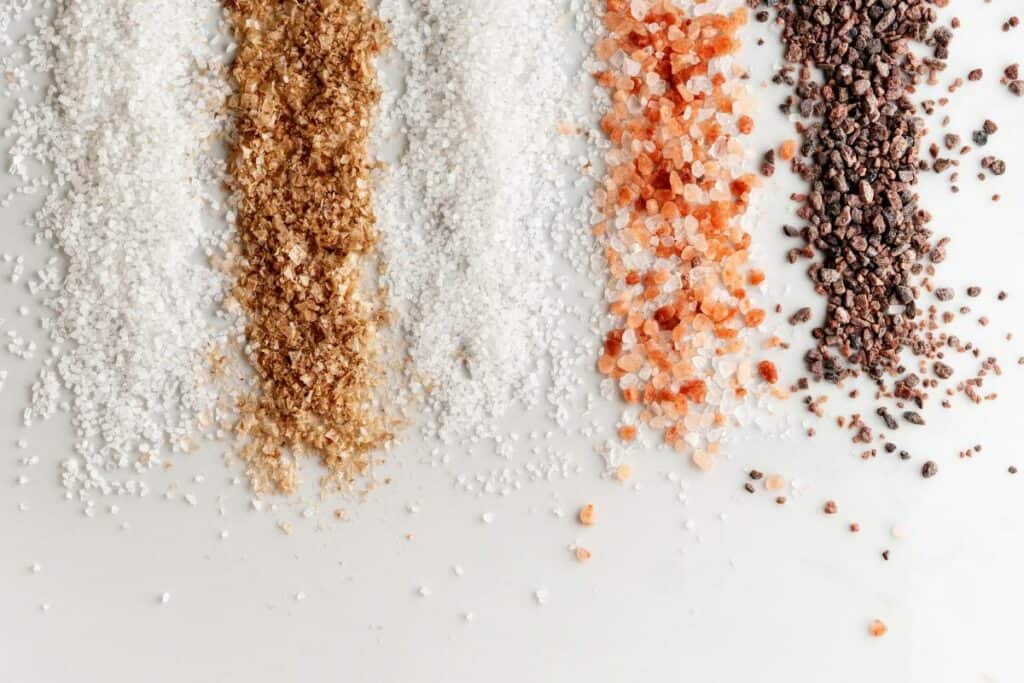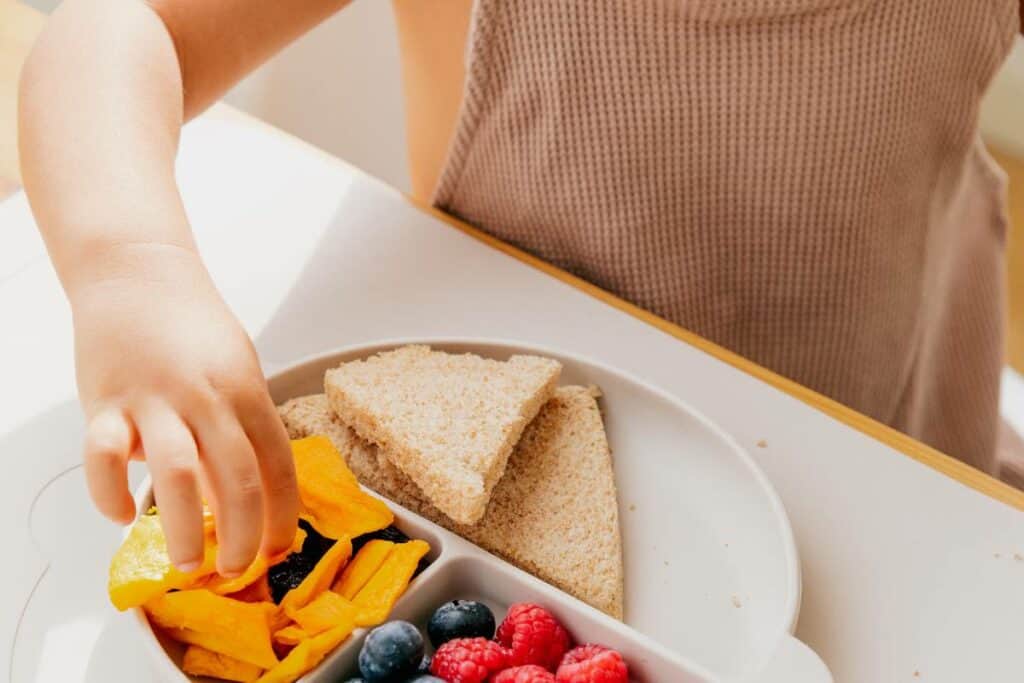Did you know?…
…The salt and sodium levels in store-bought baby food is strictly regulated.
…In making food for your baby, we advise keeping the sodium content low.
For as long as we – Registered Dietitians specializing in feeding babies – can remember, the general recommendation has been to keep excess sodium away from babies.
But, recently others are questioning this recommendation.
We love taking a deep dive into the scientific literature, especially when it’s a controversial topic. Our question of the day:
Is there a concern for a baby’s health when sodium is too high?
Let’s take a look at the evidence!
Table of Contents
What is Salt and Sodium?
First, let’s get everyone on the same page and define sodium. Sodium is a mineral essential to the human body, meaning a minimum amount is required.
- It helps maintain fluid balance in the body. If you’ve heard any buzz about ‘electrolytes’ in sports drinks, sodium is one of them.
- It collaborates with other minerals such as potassium and calcium in body functions such as muscle contraction and nerve conduction.
While it is essential to life, only a small amount is needed to support these bodily functions.
Sodium is absorbed extremely well – in fact 95-100% of the sodium ingested makes its way to the bloodstream. Compare that to iron, of which only 2-30% is absorbed and calcium, of which 20-30% is absorbed.
As an element, sodium is very reactive so it’s nearly always found paired to other molecules. We ingest sodium primarily as sodium chloride, which is what we culinarily call ‘salt,’ in monosodium glutamate, aka MSG, and in baking soda (sodium bicarbonate).
Sodium chloride is the same, regardless of which salt it’s found in: table salt, sea salt, himalayan salt, etc. The only difference is that the specialty salts have trace amounts of other minerals such as potassium and magnesium.

Which Foods Have Sodium in Them?
While whole foods naturally contain small amounts of salt, and some even have naturally occurring MSG, it’s estimated that 70% of the sodium in the average North American diet comes from processed and restaurant foods.
Foods that have high amounts of sodium include (but aren’t limited to):
- Commercial bakery products
- Mixed dishes such as frozen pizza, lasagna, microwave dinners, etc.
- Processed cheese
- Processed meats
- Canned soups, broths, and bouillon
- Condiments and sauces
- Some snacks, like chips, crackers
- Processed Allergy-friendly products (Ex. Daiya Mac and Cheese)
How Much Sodium is Recommended for Babies?
There isn’t enough research evidence to state exactly how much sodium babies should get. So, the next best evidence is to look at how much sodium babies who are healthy are ingesting and then assume that this is an appropriate amount. Like in many things related to parenthood, we do the best we can with the information we have.
The current sodium guidelines for infants are not based on high quality scientific data. What we have is an educated guess, at best.
Infants
- 0 to 6 months – 110mg/day (from human milk or formula)
- 6 to 12 months – 370mg/day (from human milk and/or formula and solid foods)
Children
- 1-3 years – 800mg/day
- 4-8 years – 1000mg/day
Since you’re likely not used to thinking in “mg of sodium,” here’s the sodium content of some common foods.
- a teaspoon of table salt has 2300mg of sodium
- Processed foods
- Canned soups and broths (Ex. Campbell’s Beef Broth, 890mg per 250mL)
- Processed meats, such as deli meats (Ex. Ziggy’s Extra Lean Smoked Chicken, 920mg per 100g)
- Processed cheese (Ex. Kraft Singles Cheese Slices, 290mg per 19g)
- Minimally processed foods
- Fermented or pickled vegetables (Ex. Store-bought Sauerkraut, 640mg per 125mL)
- Store-bought bread (Ex. Country Harvest 14 Grain Bread, 310mg per 2 slices)
- Milk (Ex. Beatrice 2%, 120mg per 250mL/1 cup)

Why is Sodium for Babies a Hot Topic?
There are three main areas of concern for why too much salt might be bad for babies:
- A baby’s kidneys are not yet fully developed when they start solids. The kidneys are responsible for regulating the amount of sodium in the blood. Instead of filtering sodium according to how much is currently present in the blood, a baby’s kidneys are programmed to filter the blood according to how much sodium is in breastmilk. This ability to match the filtering to the blood levels gradually develops and should be largely developed around 12 months of age. If blood levels of sodium get too elevated, a condition called hypernatremia could occur. This is extremely rare and only happens in extreme situations, usually alongside major dehydration, so this isn’t the main concern regarding sodium. However, minor dehydration is definitely a risk.
- Early exposure to salt could prime a baby’s taste for salty foods. Since “salty” and “highly processed” often go together, the theory is that children who eventually grow to become teens will have a higher preference (than usual) for highly processed foods if they’re primed to enjoy salty foods from an early age.
- Higher sodium intakes could increase the risk of high blood pressure as the child ages. Genetically, some people are considered salt-sensitive, meaning that higher amounts of sodium can cause high blood pressure, which is a risk factor for heart disease.
Is There any Benefit to NOT Limiting Sodium in Babies?
Initially, we were going to say that there aren’t any benefits in a higher sodium intake for babies but then we realized that wasn’t 100% accurate. There aren’t any direct health benefits for increased sodium but there could be indirect benefits to the baby and the baby’s family.
- Salted food tastes better. If your baby is rejecting plain steamed broccoli, we have to admit that we don’t blame him! We LOVE broccoli but only if it’s adequately seasoned! Adding a bit of salt could possibly increase a baby’s interest in inherently bitter foods.
- Food preparation is easier. Having a baby is tiring. If you can make one meal for your family and not worry about setting some components aside for your baby, your life as a parent would be that much easier.
- Many culturally appropriate foods are salty. Depending on where you live in the world, certain cured or preserved products might be higher in salt. As well, some sauces such as fish sauce, oyster sauce and soy may be a part of traditional recipes and all of these tend to be higher in sodium. We want to acknowledge that babies benefit from the communal aspect of eating traditional food. Plus, it’s theorized that many of these dishes are higher in minerals like potassium that draw out sodium.
What Does 390 mg of Sodium in a Day Look Like? Is This Realistic?
When establishing the recommendations for sodium intake, the researchers at the Institute of Medicine based the average intake on the following:
- A 7-12 month-old baby consumes an average of 600ml of breastmilk each day, which has an average of 35mg sodium/100ml. This comes out to 210mg sodium from breastmilk.
- A healthy 7-12 month-old baby consumes an average of 180mg sodium from complementary foods.
For argument’s sake, let’s assume that this 390mg daily target is a healthy target to aim for. What would a typical day of solid food intake look like?
Here’s a sample three-day menu designed for an 11-12 month-old baby.
Day One:
- Breakfast: Oatmeal made with ½ cup of 100% whole grain quick oats and 200mL of breastmilk topped with mashed banana (70mg of sodium)
- Snack: 4-5 unsalted crackers with a thin layer of nut butter on each (60mg of sodium)
- Lunch: Soup made with ½ cup of lentils and ¼ cup of mixed vegetables (10mg of sodium)
- Snack: 6 tbsp of Iron-fortified cereal with 60mL of breastmilk (25mg of sodium)
- Dinner: Homemade Hamburger Helper (110mg of sodium)
- Total: 274 mg of sodium + ~116mg of sodium from additional breastmilk feeding on demand = 390mg of sodium
Day Two:
- Breakfast: 6 tbsp of iron-fortified cereal with 60mL of breastmilk (25mg of sodium)
- Snack: ¼ cup of blueberries (0mg of sodium)
- Lunch: Salmon cakes and ¼ cup of cooked green beans (65mg of sodium)
- Snack: 6 tbsp of iron-fortified cereal with 60mL of breastmilk (25mg of sodium)
- Dinner: ½ cup of shredded beef with ¼ cup of cooked carrots served with ½ cup of 3.25% milk (122.5mg of sodium)
- Total: 227.5 mg of sodium + ~162.5mg of sodium from additional breastmilk feeding on demand = 390mg of sodium
Day Three:
- Breakfast: 6 tbsp of iron-fortified cereal with 60mL of breastmilk (25mg of sodium)
- Snack: ¼ cup of bite-size strawberries and ½ a cup of 3.25% milk (62.5mg of sodium)
- Lunch: Cooked lentil soup (Daal), roti and diced cucumbers (75mg of sodium)
- Snack: 6 tbsp of iron-fortified cereal with 60mL of breastmilk (25mg of sodium)
- Dinner: Tuna Casserole (40mg of sodium)
- Total: 227.5mg of sodium + 162.5mg of sodium from additional breastmilk feeding on demand = 390mg of sodium
By mindfully choosing minimally processed and low sodium food choices, it’s definitely possible to stay within the target sodium levels.

So Should I Limit My Baby’s Sodium and Salt Intake or Not?!
Whether you stuck with us and read this whole article from beginning to end or whether you skipped right to this summary section, we know what you’re most interested in is the bottom line!
This is a prime example of how nuanced nutrition is and how we don’t always have an exact answer. There are pros and cons to both sides of this coin.
Without further ado, here are the Happy Healthy Eaters’ guiding thoughts on sodium and babies:
- If you can avoid adding salt to your baby’s diet, it may be prudent to do so.
- If you find it difficult to modify your baby’s food from the rest of the family and you eat mostly homemade meals, a little extra salt is likely not going to have major ill health effects.
- If your family eats a lot of processed and restaurant foods, these foods are likely quite high in sodium and you should avoid offering them to your baby on a regular basis.
- If you occasionally offer your baby a high sodium food, don’t fret about it!
- If your baby is consistently rejecting bitter foods, adding a pinch of salt could make those foods more appealing. The benefit of ingesting and learning to accept veggies far outweighs the small risk of adding a touch of salt.
As always, we aim to strike an approachable balance of taking what’s best practice for babies’ nutrition while keeping in mind what is realistic and practical for most families. While we didn’t give you hard-and-fast answers, we hope this article has helped you determine the best course of action for you, your family, and your baby!






